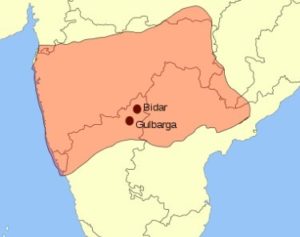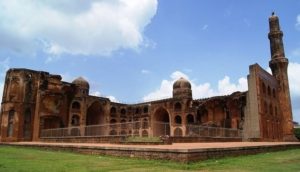Bahamani rulers of Deccan
Bahamani rulers of Deccan
Q) Write a note on Bahamani rulers of Deccan.
Structure:
It’s an open ended question. Your answer should mention the following
- Who established it
- Extent of their rule and the period
- Note on important rulers
- Brief note on the social, administrative and architecture of the kingdom
- The Bahamani Kingdom which flourished in parts of Andhrapradesh and Karnataka for almost two centuries has played a crucial role in the history of Kaarnatakaa
- It was established in 1347 D. by the Amirs who were ruling the Deccan regions as the emissaries of Muhammed Bin Tughalaq. They rose in rebellion against his rule and Hassan Gangu, the leader selected by them declared himself as the Sultan of the Dakhan region and started ruling from Daulatabad.
- He called himself Allauddin Hassan Bahaman Shah. He could expand his kingdom both by warfare and diplomacy. He gained control over important places such as Gulbarga, Warangal, Jamakhan di, Kalyana, Dabolim and Goa in a phased manner.

- At one time his empire extended from Berar in the north right up to the Krishna River in the Arabian Sea in the west and Hyderabad in the east were the boundaries of his kingdom.
- He divided his kingdom in to four parts (tarafs) for administrative convenience and Bidar, Berar, Daulatabad and Gulbarga were the head quarters of these tarafs.
- He was a benevolent king and he was the first Muslim king who did not levy Jejia on He encouraged local trade by levying a tax on imports. He shifted his capital to Gulbarga and named it Ehsanaabad.
- Mahmud Shah-1(1358-75) the next king was the first son of Bahaman
- He could stabilize the kingdom and establish peace and prosperity
- He waged wars against the Vijayanagara empire and the King of Telangana region and there by annexe Mudgal and Golconda for his kingdom
- He was responsible for many administrative reforms
- Mahmud Shah was succeeded by many more kings who faced relative instability and were pestered by in fights for power.
- Bahamani regained its glory during the regime of Tajuddin Fairoze who ruled for 25 (1397-1422). He regained the control over Doab region of Raichur and sent an emissary to Taimur’s royal court.
- In 1422, Shihabuddin over threw his brother, ascended the throne and shifted the capital from Gulbarga to Bidar.

- His rule was replete with many conquests and he could collect land and other bounties from the emperors of Vijayanagara, monarchs of Varangal and the kings of Malva and His reign was noteworthy because of many secular, administrative and social changes set in motion by him.
- The duration of the next fifty years is known more for the deeds of Mahmud Gawan (1411-81) the premier rather than the kings that he worked under.
- He worked under three monarchs and rendered yeoman service to the kings as well as general public
- He was a scholar, educationist and art conniesuer even though he was a rich merchant by prrrofession
- He was well versed in Islamic lore, Persian language and mathematics
- In 1472 A. D. he established a Madrassah in Bidar, then the capital of the Bahmanis. The Madrassah had an imposing three-story building with 100 feet tall minarets in four corners.
- The library contained more than 3000 manuscripts. There were thirty-six rooms for students and six suites for the teaching staff. It also had big lecture halls and a prayer hall. Gawan himself had a personal library of more than a thousand books.
- In addition to these he was a part of many military operations and administrative reforms undertaken by the kings
- Unfortunately he was executed by Muhammaed-3 on trumped up charges of That marked the end of an honest statesman and educationist.
- The disintegration of the Bahamani kingdom started with the death of Gawan
- The last four kings from Ahmed-4 to Kalimulla who ruled between 1518 and 1538 presided over that process
- The rulers of Berar, Ahmednagar, Bijapur and Telangana decalred themselves as independent and thus ended the Bahamani kingdowm
The Bahamani rule was remarkable for its administrative reforms in all the wings namely the army, the executive and the judiciary. These were carried out over a period of time under different kings. The socio economic situation under went many changes. It was essentially a period of transition to feudalism and centralization eroding in to the freedom of village leaders. The rulers were by and large secular and tolerated all religions. The pan Indian movement of Bhakti had a lasting influence. Sufism also had a firm base in the masses and enjoyed royal support. Most of the architectural achievements of the Bahamani rulers are to be found in Bijapur, Gulbarga and Bidar. Most of the inscriptions installed during the Bahamani rule are in Arabic and Persian. Some of them are bi-lingual using Kannada, Marathi and Telugu. They are interesting from the point of view of calligraphy. The kingdom had its own mints in Daulatabad, Gulbarga and Bidar.
All in all the regime of the Bahamani constitutes an important chapter on the political and cultural history of Karnataka.

